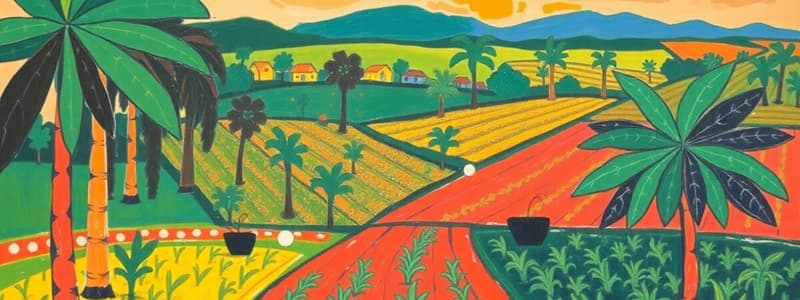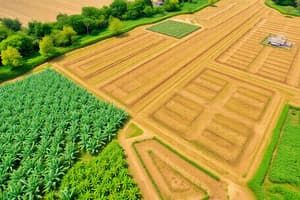Podcast
Questions and Answers
What type of agriculture was practiced by the indigenous peoples of the Caribbean before European arrival?
What type of agriculture was practiced by the indigenous peoples of the Caribbean before European arrival?
- Monoculture farming
- Subsistence farming
- Communal agriculture (correct)
- Industrial agriculture
What was the primary purpose of the encomienda system introduced by the Spanish?
What was the primary purpose of the encomienda system introduced by the Spanish?
- To ensure food security for Spanish settlers
- To exploit indigenous labor for agriculture and mining (correct)
- To establish formal trade relations with indigenous groups
- To promote agricultural diversity
Which production system became dominant due to the transatlantic slave trade?
Which production system became dominant due to the transatlantic slave trade?
- Indentureship system
- Encomienda system
- Cooperative farming
- Plantation system (correct)
What was a significant effect of the slavery and plantation system on the Caribbean region?
What was a significant effect of the slavery and plantation system on the Caribbean region?
What characterized the indentureship system in the Caribbean after the abolition of slavery?
What characterized the indentureship system in the Caribbean after the abolition of slavery?
How did the pre-Columbian agriculture system contribute to the community structure in the Caribbean?
How did the pre-Columbian agriculture system contribute to the community structure in the Caribbean?
What was one of the consequences of the encomienda system on the indigenous population?
What was one of the consequences of the encomienda system on the indigenous population?
What was a significant result of the diverse production systems in the Caribbean?
What was a significant result of the diverse production systems in the Caribbean?
Flashcards
Pre-Columbian Agriculture
Pre-Columbian Agriculture
Indigenous Caribbean farming systems before European arrival, emphasizing communal ownership and crop cultivation for community needs.
Encomienda System
Encomienda System
Spanish system of forced labor in the 16th century, where indigenous people were assigned to Spanish settlers for exploitation in agriculture and mining.
Plantation System
Plantation System
Large-scale agricultural system focused on single crops, using enslaved labor, that dominated Caribbean production after the transatlantic slave trade.
Transatlantic Slave Trade
Transatlantic Slave Trade
Signup and view all the flashcards
Indentured Labor
Indentured Labor
Signup and view all the flashcards
Communal Agriculture
Communal Agriculture
Signup and view all the flashcards
Abolition of Slavery
Abolition of Slavery
Signup and view all the flashcards
Caribbean Production Systems
Caribbean Production Systems
Signup and view all the flashcards
Study Notes
Caribbean Production Systems: Development Overview
- Caribbean production systems have a long and complex history, shaped significantly by socio-economic, political, and environmental factors.
- Indigenous peoples practiced communal agriculture before the arrival of Europeans.
- This involved shared land ownership and community-focused farming.
Pre-Columbian Era
- Indigenous groups, such as the Tainos and Caribs, practiced communal agriculture, ensuring food security and social cohesion.
Spanish Colonialism: The Encomienda System
- The encomienda system, imposed by the Spanish, assigned indigenous people to Spanish settlers for work in agriculture and mining.
- Encomenderos were meant to offer protection and religious instruction but this system instead led to the exploitation and decline of the indigenous population.
The Plantation System
- The transatlantic slave trade brought millions of Africans to the Caribbean to work on large-scale sugar plantations.
- This system involved monoculture, and gang labor, deeply impacting land ownership, agricultural methods, and Caribbean demographics.
Post-Abolition: Indentureship
- After the abolition of slavery, indentured laborers from India and China were brought to work on plantations.
- These laborers signed contracts for a set period, often including an option to return home.
- Indentureship added to the cultural diversity of the region.
Studying That Suits You
Use AI to generate personalized quizzes and flashcards to suit your learning preferences.




